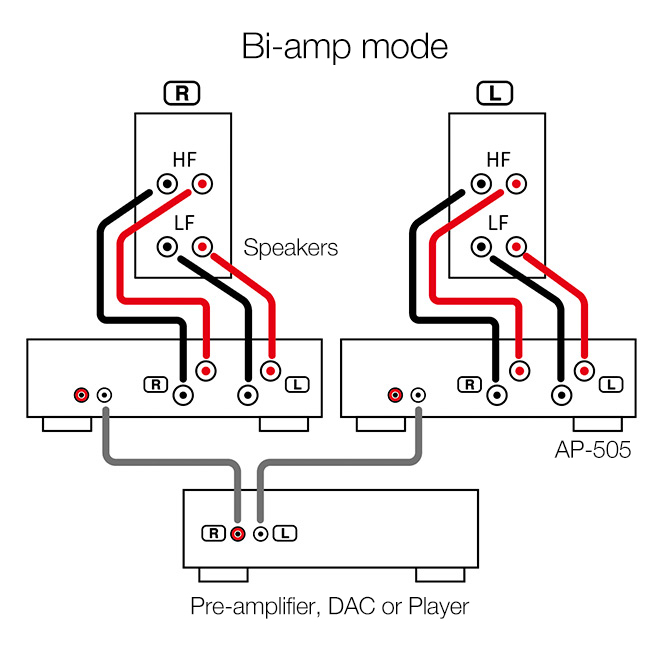With a never quest for better sound is part of the excitement of being an audiophile. Once you’ve caught the “bug” and put together a respectable home theater or home audio system, the second move is to explore and tweak.
If you’ve gotten this far, you’ve probably heard the terms bi-amping and bi-wiring. Many people question whether these set-ups have an impact on your audio system. Let’s go over what all of these terms implies and how they can help you boost the quality of your audio setup.

What Is Bi-Wiring
There is a lot of disagreement about how and if bi-wiring actually operates. In our observation, every moment we carefully bi-wired a speaker, we noticed an increase in resolution and clarity. In three-dimensional area, the sound appears to be more exact.

Bi-wiring involves the use of 2 separate lengths of 2 conductor cables. A set of cables are connected to a single pair of terminals at the amplifier, while at the speaker end – the cable splits into two to connect to the binding post of the speakers.
When using a bi-wiring arrangement, the separate connections at the crossover which keep the different frequencies separate.

How to Bi-Wire Your Speakers
Remove the switches and use two pairs of speaker wires to bi-wire your speakers. They will normally split at the speaker side and be connected together at the amplifier end or receiver (see image above). Some higher-end amplifiers also contain two pairs of speaker connectors to make it simpler to attach.
It is important that you utilize the same wires. They should all be the same model, manufacturer, and size. If you don’t, you’re modifying the electrical characteristics of the wire and, as a result, the sound.
Check that all of the speaker connectors are solid and tight, and that the positive terminal is not contacting the negative terminal in any manner. If you’re working with bare wire, even a small strand of wire hitting the wrong terminal will gradually harm and destroy your amp. Generally, utilizing correctly pre-terminated wire is your best option.
What Is Bi-Amping?
Now let’s look at bi-amping. To bi-amp, you must first bi-wire. Bi-amping, on the contrary, takes matters a stage further by using a different amplifier for the bass and treble connections at your speaker. The distinction between passive bi-amping and active bi-amping is not frequently discussed.
Certainly, overkill is often a concern, but generally, we consider that there is no such thing as too much power powering your speakers. It’s comparable to operating a high-performance vehicle.

You may not require the energy all of the time, but when you do, it will perform admirably. Musical requirements are a lot like driving over the mountains: sometimes you can cruise, but other occasions you need a lot of power backup.
While some individuals believe that having too much power will “blow out” your speakers, it is actually having insufficient power that will cause the most harm. If you use an amp that is too tiny for your speakers and push it too aggressively to play loudly, the amp may fail and transmit a highly distorted signal to your speakers. This is the source of the problem. Those sudden demands simply sail through with a lot of power.
Because bi-amping involves two amplifiers, it provides you with extra power as well as the advantages of bi-wiring.
Pros of Bi-Amping
- Frequency crossover happens at the line level rather than at higher speaker levels
- Each amp takes less energy to run
- There is less risk of blowing or overloading the tweeters
- Better and clear audio as a result of separate drivers not having to struggle to work from outside their frequency spectrum.
Cons of Bi-Amping
- The frequency bands of the active crossover and the speaker drivers will need to be calibrated using high-quality measuring gear.
Bi-Amping With a Passive System
When bi-amping is described, it is usually in the context of passive bi-amping. This is the most typical. With passive bi-amping, you continue to use your speaker’s crossover sections to convey the right tones to each speaker motor.
As with bi-wiring, equilibrium is critical in passive bi-amping, but it goes a level beyond. Your speaker cables must be the same, as must the linking audio wires that link to each amp. Lastly, the amplifiers must be the same or from the same manufacturer, with the precise same specifications in a couple of important aspects.
Every amplifier has a feature known as input sensitivity. This is a number that indicates how much energy it outputs with a specific level of input signal. If you use two amps with differing input sensitivities to bi-amp, one of your speaker’s bass or treble sections will be stronger than the other, which is not desirable.
The output resistance specification of the amplifier also influences how it responds to your speakers. Our suggestion is to be cautious – if you want to experiment with bi-amping, be sure the two amps are similar.
This process is simplified by a few latest amplifiers and receivers on the industry. You can allocate four amplifier channels for bi-amping in the configuration menu, giving you four equal amp pathways that make everything function properly.
Pros of Passive Bi-Amping
- There is no need to buy a second active crossover network
Cons of Passive Bi-Amping
- The cords used must be same
- The amplifiers used must be similar models
- The speakers must be same
Active Bi-Amping System
With an active system, you can also bi-amp. Active bi-amping uses an active crossover which filters electronic signals (into higher and lower frequencies) before it reaches the amplifier. The advantage here is that each amplifier only deals with the load assigned to it and hence there is greater room for efficiency.
Intermodulation distortion is reduced as each amplifier is producing a smaller range of the audio frequency spectrum.

This solution, however, will necessitate the use of different power amplifiers as well as an electronic crossover. It is not possible to do so with ancient integrated amplifiers or stereo receivers. Furthermore, there are relatively few speakers on the market that enable you to dynamically bi-amp. Frankly, if you had a set of these speakers, you’d just be bi-amping them.
Pros of Active Bi-Amping
- The crossover provides each amp with its own filtered audio input
- The amps do not have to be identical
Cons of Active Bi-Amping
- If the speaker has an inbuilt crossover, you must ignore or remove it, which can be pricey
- You’ll need to buy an active electronic crossover
Vertical and Horizontal Bi-Amping
These configurations entail rerouting separate amplifier routes. They both can be configured to be passive or active bi-amping with the location and selection of crossover circuits in the signal path.
Vertical bi-amping is when one amplifier is dedicated towards each speaker’s HF and one amplifier is dedicated to its LF. Each speaker receives its own set of amps that are wired to only that speaker. The sound signal is sent to the set of amplifiers.
One of the amp channels transmits speaker frequency sound to the tweeter of the speaker. The other amp channel drives the woofer with speaker-level sounds. Typically, this system consists of two stereo amplifiers, one for each speaker.
Pros of Vertical Bi-Amping
- Each amp’s strength isn’t entirely concentrated on transmitting power to both the tweeter and woofer, which keeps the amplifier from overburdening itself and saves electricity.
Cons of Vertical Bi-Amping
- You’ll almost certainly have to employ a passive bi-amp configuration, which means you’ll be dependent on the speaker’s inherent crossover filter.
Horizontal bi-amping is the practice of dedicating each pairing of stereo amps to conveying a particular screened frequency range. One amp’s right and left channels are routed to the tweeters of each speaker. The other amp’s right and left channels are routed to the woofers of each speaker.
This will almost certainly constantly be an active bi-amp configuration. It would be pointless to depend solely on the speaker’s inbuilt crossover systems in this case.
Pro of Horizontal Bi-Amping
- Lets the user to utilize two distinct amplifier types, each of which may be better suited to various frequency bands
Cons of Horizontal Bi-Amping
- Skilled metering equipment are required to balance varied levels between different amps
- There is no specialized amp for the middle frequencies (assuming the speaker has a middle driver), which can lead in a murky midrange tone.
Understanding The Science Behind Bi-Amping
If you want to get deeper into the principles of bi-amping, we’ll need to go over some sound science. It’s critical to know and use principles like audio frequencies, audio signal flow, and how a speaker physically works.
It is necessary to read and learn about these principles in order to avoid being lost.
Frequencies
Everything we hear can be quantified in frequencies; in case you didn’t know. These frequencies are expressed in cycles per second or Hertz. When listening to music, you will hear a variety of frequencies at the same time. You can use an equalizer to improve your hearing of these distinct frequencies.
In a nutshell, sound waves cause changes in air pressure. Pressure forces that cycle quickly enough produce audible sound. Sound waves with a greater frequency have a higher number of wave cycles per second. Higher frequencies are seen as having a higher pitch than lower frequencies.
Signal Flow
It’s essential to know how the sound signal travels from the amplifier’s input to the speaker unit. Assume you have a speaker, an output device, an amplifier, and an audio signal.
In this case, the initial point is the physical socket where the signals exits the output of some device—usually the headphone socket of a phone, laptop, television, or the console outputs.
As the signal enters the amp’s input, it is at line level. In this case, the amplifier boosts the signal to speaker frequency, which is a higher power for driving speakers.
A speaker functions as a converter, transferring the energy that passes through it from one type to another. In this situation, the speaker converts the electrical audio signal to mechanical energy, which moves the cone of the speaker.
Conclusion
Finally, now that you have a better understanding of bi-amping and bi-wiring, you will be able to save a lot of money. All you need are two matching pairs of speaker cables and a set of decent speakers. Don’t overlook the main channel speaker if you have a fantastic home theater. Most high-performance center channel speakers have bi-wiring interfaces.
If your receiver or amplifier is formed for bi-amping, we recommend you test it as well. The only expense, like with bi-wiring, is for the cables.
Getting two amplifiers to bi-amp, on the other hand, leads us down a different route. For the same expenditure, would you be better off with one fantastic amp or two mediocre amps? Our recommendation is to acquire a better bi-wire and amplifier.
You must also consider your entire system. Is it best to keep your present amp and update to higher functioning speakers, or to acquire two amplifiers to bi-amp the ones you already have? In most cases, the speaker improvement is preferable.
We hope this helps you comprehend bi-amping and bi-wiring as you proceed on your quest to perfect your sound!
You may also be interested in:
- 8 Best Integrated Amplifiers under $1000
- Different Types of Amplifier Classes Explained
- Amplifiers vs Receivers: What’s The Difference?
